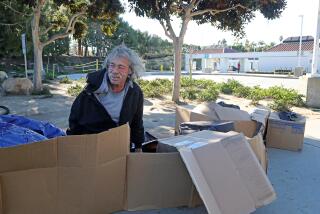L.A. Planning Commission proposes ban on billboards, supergraphics
The Los Angeles Planning Commission voted Thursday to recommend dramatically reworked restrictions on signs that would ban digital billboards and supergraphics -- the vinyl signs stretched across the sides of buildings -- throughout most of the city.
Under the proposal, most new signs in Los Angeles -- including “sale” signs painted on storefront windows and gas station pole signs -- would be significantly smaller than those currently allowed, half the size in some cases. Signs and billboards that already have city permits would not be affected by the measure.
The commission voted 6 to 3 to forward the ordinance to the City Council, which is expected to vote on the measure by June, when a temporary sign moratorium is set to expire.
Voting against the measure were commissioners Michael Woo, Cindy Montanez and Father Spencer Kezios. Last week, they voiced dismay that the plan provided too many exceptions for new signs. Outdoor advertising companies successfully used such exceptions to strike down in court the city’s 2002 billboard ban.
Commissioners Sean Burton and William Roschen disagreed, saying the new law would result in a significant reduction in billboards and outdoor signs.
“It’s so much better than where we are now. The reductions are substantial,” said Roschen, president of the commission. “A lot of the folks who want more signage are probably not happy with this. A lot of folks who want a lot less are not going to be happy with it. But I think this allows enough balance to serve the entire city.”
Although the measure would still allow the council to create as many as 21 special sign districts in neighborhoods such as Encino, Westwood and Boyle Heights, the commission voted to require that for each new sign erected, a sign of equal or greater size would have to be taken down in the surrounding area.
The intent of the sign districts is to carve out L.A.’s busy, urban pockets or commercial hubs where billboards, supergraphics or other signs outlawed elsewhere in the city might be a better fit. Sign districts also could be created to impose more intense restrictions on signs.
In either case, both the Planning Commission and City Council would review all applications for the districts. For each, the council would need to make special findings that such signs would enhance a neighborhood’s “unique quality, theme or character.”
Woo unsuccessfully tried to persuade the commission to limit sign districts to areas with entertainment or cultural appeal. “Hollywood makes sense to me as a sign district; it’s an entertainment area. L.A. Live and Staples Center make sense to me. But why Ventura Boulevard? Why Van Nuys?” Woo said.
In recent weeks, representatives from Mayor Antonio Villaraigosa’s office urged the commissioners to wrap up their extended deliberations and keep the proposed sign districts, according to several people close to the deliberations.
“We know where the mayor stands on it,” Roschen said after the hearing in Van Nuys. “I think he’s pro-business. I think he understands the value of sign districts and the idea of elegant density.”
Dennis Hathaway of the Coalition to Ban Billboard Blight said that overall, the new sign ordinance could “potentially” lead to a substantial reduction in signs cluttering neighborhoods and the Los Angeles skyline. But that comes with many caveats.
“If the sign ordinance works as it’s intended, if it doesn’t get riddled with lawsuits, if the City Council doesn’t tamper with it and put in exceptions . . . it can really, over the long term, reduce the amount of commercial advertising in the city’s open space,” Hathaway said.
--
More to Read
Sign up for Essential California
The most important California stories and recommendations in your inbox every morning.
You may occasionally receive promotional content from the Los Angeles Times.











